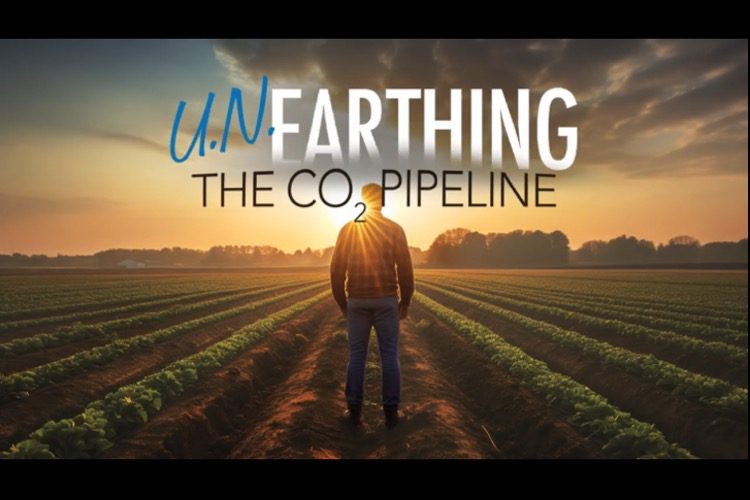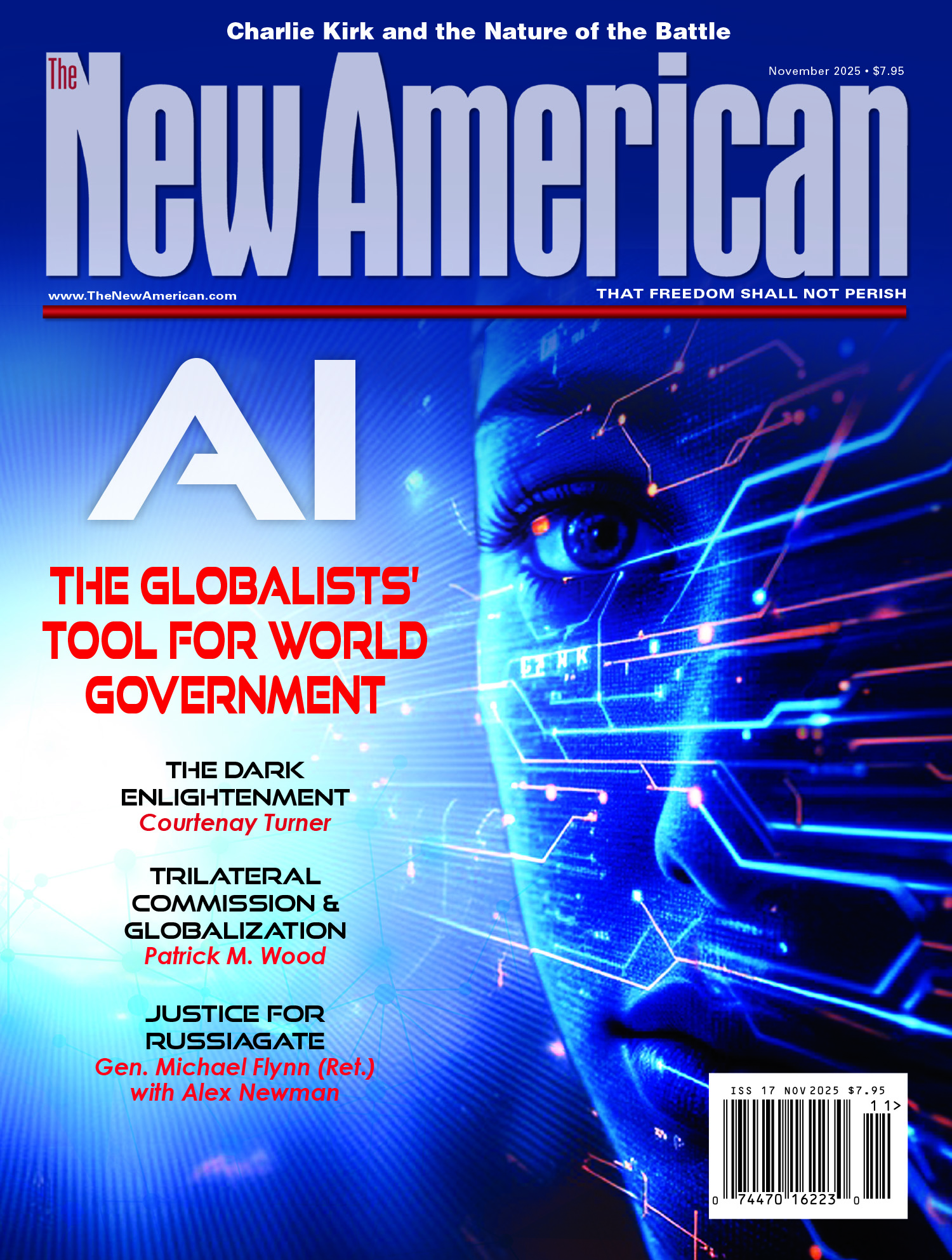
Is it “carbon capture” — or property rights, cash, and Constitution capture? This is the question explored, and answered, by the alarming new documentary U.N.Earthing: The CO2 Pipeline. Produced by the John Birch Society and released on Earth Day (April 22), it warns of a man-made peril beneath the earth, one that could be coming to a town near you.
What is carbon capture (CC)? Grok AI puts it very succinctly, writing that it “is a process that traps carbon dioxide (CO₂) emissions from sources like power plants, industrial facilities, or directly from the air, preventing it from entering the atmosphere. The captured CO₂ is then stored underground, used in industrial processes, or converted into products.” The pretext for it is combating “global warming,” “climate change,” “global climate disruption,” or whatever the nom du jour will be when this essay is published. Of course, CO2 — regularly called “carbon,” which is like calling water “hydrogen” — is implicated in this repent-the-end-is-nigh, doomsayer scenario. Never mind that botanists pump the gas into their greenhouses because it facilitates plant growth. (Crop yields rise notably along with CO2 levels.) Never mind that astrobiologist Jack O’Malley-James predicted in 2013 that life on Earth would end due to too little CO2 (albeit in a billion years). Never mind that Bjørn Lomborg of the Copenhagen Consensus Center has predicted that lowering Earth’s temperature one-third of one degree by this century’s end would cost $100 trillion (which still may be lower than our national debt in 2100). Never mind that even the liberal New York Times admitted in 2016, reporting on a Lancet study, that “cold weather is responsible, directly or indirectly, for 17 times as many deaths as hot weather.” And never mind that some scientists believe another ice age is approaching. There’s carbon and cash to capture.
The carbon-capture pipeline (CCP) is a massive undertaking, too. Funded with your tax dollars, the CCP is an $8.9 billion project that would snake 96,000 miles all throughout the United States. Even more significantly, it is setting property-rights precedents that, turning the “man’s home is his castle” principle on its head, could affect Americans coast to coast and here to eternity.
Now, while Grok’s CC definition may sound innocuous enough, U.N.Earthing (UNE) explains that the pipeline scheme is anything but. It involves capturing CO2 from industrial sources, compressing it, and then sending the “semi-liquid” hundreds of miles to an underground “amalgamation” area in North Dakota. The term “compressed” can get your attention. It sure got mine, reminding me of the can of Coke I left in my freezer too long (I’d wanted to cool it down quickly; I was a Coke addict at the time). Upon very gentle removal — I handled it like nitroglycerin — the ill-fated can exploded like a grenade. It created the kind of mess that after a long day’s work would, were I not the testosterone-oozing culture warrior you know and love, have evoked tears. And sure, this may rightly bring a chuckle at my expense; unfortunately, when a CO2 pipeline can’t take the pressure, the result isn’t even slightly comedic. This brings us to a story.
While CO2 is a naturally occurring, life-giving gas, it can do more when compressed than just create schmutz. Just consider the Lake Nyos disaster.
Lake Nyos in Cameroon, Africa, is a deep, volcanic crater lake that on August 21, 1986 suddenly released a huge cloud of CO2. Because the gas is heavier than oxygen, it displaced the latter. The result was that 1,700 people and countless animals suffocated to death in short order. Note here that the CO2 had long been present in the lake’s cold depths in, loosely put, a compressed state — much like it will be in the CCP. So does such a pipeline sound like a disaster waiting to happen?
It already has.
UNE recounts a fateful day in February 2020 when a CO2 pipeline ruptured in the town of Satartia, Mississippi. Much as in Cameroon, people saw the ominous cloud and couldn’t breathe; some collapsed in their homes, experiencing symptoms such as dizziness, nausea, disorientation, convulsions, and unconsciousness. If you were driving at the time, that didn’t help you because cars stalled out (combustion requires oxygen). Note, too, that it took 4½ hours for the pipeline to empty.
Ultimately, at least 45 people were hospitalized, and hundreds had to be evacuated. No, it wasn’t a Lake Nyos-level disaster but, well, “‘We got lucky,’ said Yazoo County Emergency Management Agency director Jack Willingham,” reported the Freesoil Foundation in 2024. “‘If the wind blew the other way, if it’d been later when people were sleeping, we would have had deaths.’” The Foundation also points out that CO2 “has long been used to euthanize laboratory rodents and other small animals” (though many now consider this inhumane). So its angel-of-death potential is well known.
Oh, and what caused the pipeline to burst? It was “normal seasonal flooding.” The kicker:
The pipe ruptured again while being repaired just months later — necessitating yet another evacuation. This is unsurprising, too, as UNE informs that there are no federal regulations on CO2 pipelines; moreover, the CCP would be grandfathered in and not subject to new safety regulations.
This said, all human endeavor involves risk, and energy production-related matters are no exception. For example, does the infamous 1979 Three Mile Island Nuclear Generating Station meltdown mean we should dispense with atomic energy? Nuclear has a profound upside, of course. But what of carbon capture and storage’s (CCS’) risk? Does a cost-benefit analysis justify it?
Apropos here, environmentalist Nigel Calder warned at the first Earth Day celebration, in 1969, that the “threat of a new ice age must now stand alongside nuclear war as a likely source of wholesale death and misery for mankind.” Now, on the heels of the 46th Earth Day, UNE points out that global-warming doomsayers’ prognostications have likewise been found wanting, causing them to rely instead on prevarication and ploy. For example, it talks about a certain legislative Trojan horse used to fund CCS. The documentary also illustrates how even fully effected the endeavor wouldn’t be effective; why, it quotes warmist hell-raiser Al Gore himself throwing shade on it. In fact, both Left and Right agree that CCS won’t lower temperatures, so where’s the benefit?
And why is it full steam ahead?
Well, follow the money. UNE reveals, too, who’s collecting our tax dollars through CCS (to the tune of billions), providing numbers and naming names. And how are these greentopian greenback chasers facilitating their business?
Well, hit films have been made, such as Shane (1953) and Pale Rider (1985), about powerful, greedy, big-money interests using strong-arm tactics to drive the little guys from their land. UNE exposes how the company building the CCP, Summit Carbon Solutions, has embraced this spirit — only, using not warfare but lawfare. It basically makes property owners, often ranchers and farmers, an offer “they can’t refuse”: Play ball with us, or we’ll use eminent domain and do whatever we want.
UNE also reveals how state and some county governments, and judges, have been complicit in this, and how Summit will go nadir-low to achieve its ends. It preys on the vulnerable: widows, the weak, even a man suffering dementia. It uses bullying tactics and intimidation, threatening counties with legal action and even suing the deceased.
And once Summit gets what it wants, an easement or lease, it’s the best of both worlds — for the company. That is, the landowners still pay the property taxes, but the company now has some control over the property. You may need their permission to build on the pipeline area; may not be allowed to target shoot on your own land; and if, let’s say, your tractor sinks a few feet in wet earth and disrupts the pipeline, you may be liable for any damages and deaths. In a nutshell, it’s like a species of fascism: The land is still privately owned, but the company, abetted by the government, has some hold on it.
UNE provides, of course, many more details. The work is also replete with interviews with ranchers, farmers, and government officials, thus putting human faces on the oppression — and its opposition. The documentary explains as well, for example, how Summit
- is draining deep aquifers, necessary for agriculture, and how its actions could render that water impotable;
- destroys underground drainage systems;
- removes good food-producing land from agricultural use; and
- will use the liquefied CO2 for fracking despite promising it wouldn’t.
We also learn from UNE how the feds dealt with greentopian climate policy’s unpopularity: Not at all constrained by the truth-in-advertising imperative, the government incentivized CC tech via the Inflation Reduction Act, which provided companies “cash in hand.”
As bad as CCS is, however, even worse, asserts UNE, is that it’s merely part of a much larger agenda than even just the fantastic goal of achieving “net zero” by 2050. Thus does the documentary also answer the following questions:
- How many decades of CCS “projects” are planned?
- What is “Agenda 2030,” how does CCS intersect with it, what are its 17 goals, and what policy initiative is it masquerading as in the U.S.?
- What is “30 by 30” and “50 by 50” and how do they enter the equation?
- What are the “15-minutes cities” greentopians want us all sardine-canned into?
- Is this really about the technocratic control and regionalization of government, the removal of private property rights, the undermining of individual liberties, the centralization of the food supply, and the “own nothing, be happy” principle?
- Does the agenda even include attaining control over “what, when, and how you buy?”
That last bullet point sounds, of course, quite biblical. That is, the Book of Revelation warned 2,000 years ago that a time would come when no one would “be able to buy or to sell, save he that hath the mark, either the name of the beast or the number of his name.” While this sounds ominous, however, don’t run for the Prozac just yet because UNE offers one more thing: hope.
The work explains how South Dakotans dealt CCS a blow via a referendum, and that Summit has had to delay the CCP’s start-up date because of grassroots opposition. UNE also outlines how you can get involved, fight the good fight, and become another David helping to slay the Goliath. It really is quite inspirational.
UNE is also very smartly made, polished, captivating, and cohesive with no perceptible cinematic hamburger helper; there are no wasted words. One segment segues so beautifully to the next that it’s sometimes hard to even conceptualize them as segments. The work moves quickly but is not rushed, is informationally sating but not overwhelming. The documentary is 52 minutes long.
UNE will alarm you, then arm you as it reminds us of a simple truth: You may not care about politics, but politics sure does care about you. If we’re not vigilant, some day soon it may not just be America’s purple mountain majesties that take our breath away.




